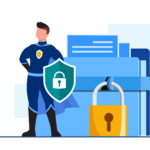Shopify store opens up a world of opportunities to connect with a global audience and build a thriving e-commerce business. However, this convenience comes hand in hand with the responsibility of safeguarding your Shopify store from potential cyberattacks and reputation pitfalls. In this comprehensive guide, we’ll delve into the specifics of how to secure your online business, explaining each step in straightforward language and providing external resources for further insights.
Protecting Your Shopify Store From Cyber Attacks and Reputation Mistakes
Running a successful online business involves more than just setting up shop and selling products. It requires a vigilant approach to safeguard your Shopify store from cyber threats and reputation-damaging mistakes. In this blog, we’ll explore in-depth strategies to keep your e-commerce venture secure and maintain a stellar reputation, all presented in a clear and accessible manner.
1. Secure Your Shopify Store
a. Strong Passwords and 2FA
Your journey to securing your Shopify store begins with robust passwords and Two-Factor Authentication (2FA). Start with a unique and complex password, avoiding easily guessable combinations. Additionally, enable 2FA for an added layer of protection, ensuring that even if your password is compromised, your store remains safe.
External Resource: Shopify – Setting up two-factor authentication (2FA)
b. Regular Updates
Regularly update your Shopify store. These updates include security patches that fix known vulnerabilities. Neglecting updates can leave your store susceptible to exploitation by cybercriminals.
External Resource: Shopify – Updating Shopify
2. Protect Customer Data
a. SSL Encryption
Ensure your website employs SSL (Secure Sockets Layer) encryption to protect customer data, including personal information and payment details. Shopify provides SSL certificates for free, making this a non-negotiable security measure.
External Resource: Shopify – Activating SSL certificates
b. GDPR Compliance
For those serving customers in the European Union, GDPR compliance is essential. This includes obtaining explicit consent for data collection, allowing customers to access and delete their data, and promptly notifying them of any data breaches.
3. Educate Your Team
a. Employee Training
Cybersecurity is a collaborative effort. Train your employees to recognize phishing scams, understand the risks associated with clicking on suspicious links, and report any unusual activity immediately.
b. Security Policies
Develop clear security policies and guidelines for your team to follow. Ensure everyone comprehends the consequences of non-compliance, fostering a culture of security awareness.
External Resource: Shopify – Employee roles and permissions
4. Monitor and Detect Threats
a. Web Application Firewall (WAF)
Implement a Web Application Firewall (WAF) to protect your Shopify store from common online threats and DDoS attacks. A WAF filters incoming web traffic, identifying and blocking suspicious activity.
b. Continuous Monitoring
Employ security tools for real-time monitoring of your store’s activity. These tools are invaluable for detecting unusual behavior or unauthorized access.
External Resource: Shopify – Security for your store
5. Backup Your Data
a. Regular Backups
Create regular backups of your website and customer data. These backups ensure you can swiftly recover your store in the event of a data breach or cyberattack. Shopify offers automated daily backups.
b. Secure Backup Storage
Store your backups in a secure, offsite location to safeguard your data against server failures, natural disasters, or other catastrophic events.
External Resource: Shopify – Backups
6. Handling Customer Disputes Responsibly
a. Excellent Customer Service
Exceptional customer service is your armor against reputation mistakes. Address customer issues promptly and professionally, fostering customer satisfaction and loyalty.
b. Offer Clear Refund and Return Policies
Clearly state your refund and return policies on your website, ensuring transparency in your business dealings. Make sure these policies are fair and in compliance with legal requirements.
External Resource: Shopify – Handling customer disputes
7. Online Reputation Management
a. Monitor Online Mentions
Regularly monitor your store’s online mentions on social media and review websites. Utilize tools like Google Alerts to keep track of what people are saying about your business.
b. Respond to Negative Reviews
Engage with negative reviews in a professional and constructive manner. Strive to resolve customer complaints and demonstrate your commitment to delivering exceptional service.
Conclusion:
As the e-commerce landscape continues to evolve, it’s more important than ever to take proactive steps to protect your Shopify store from cyber threats and reputation pitfalls. Your online business’s success depends on a strong and secure foundation. By following the detailed steps and utilizing the external resources provided in this guide, you’re not only safeguarding your store but also building trust with your customers. This trust is the cornerstone of long-term success in the e-commerce world, ensuring that your Shopify store continues to thrive and serve your customers effectively.


